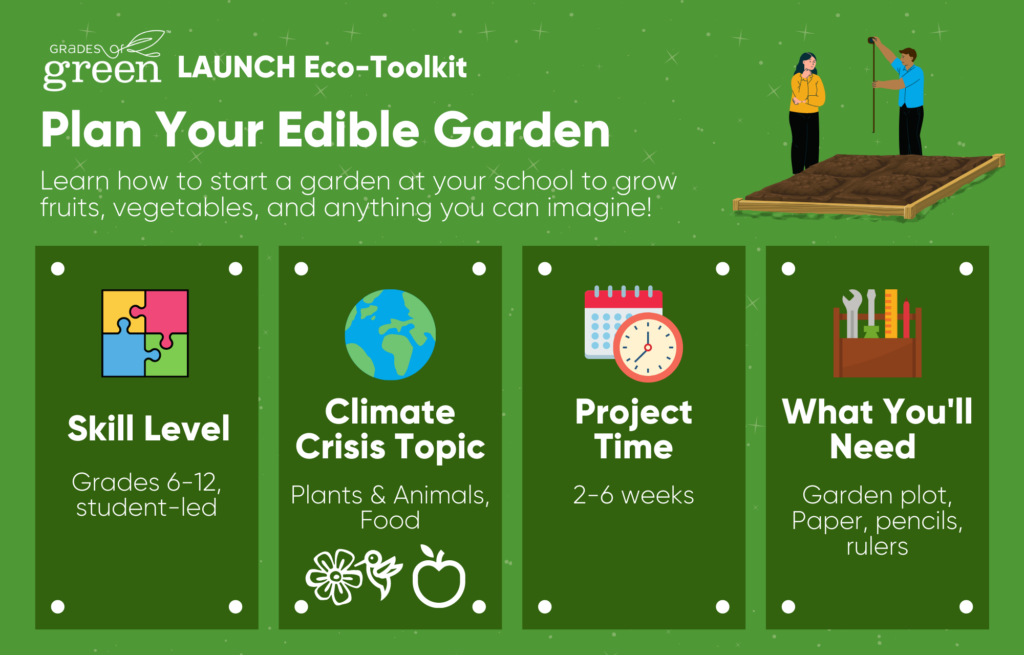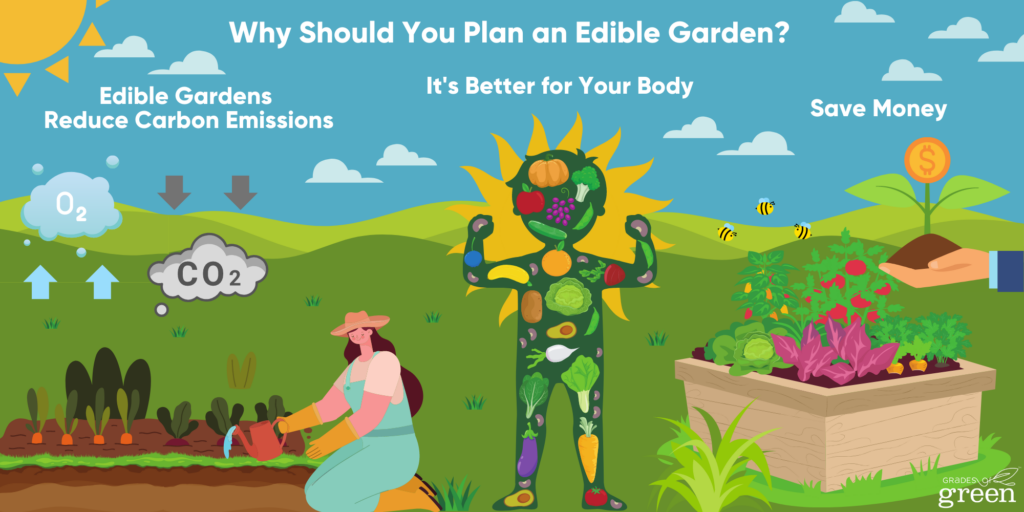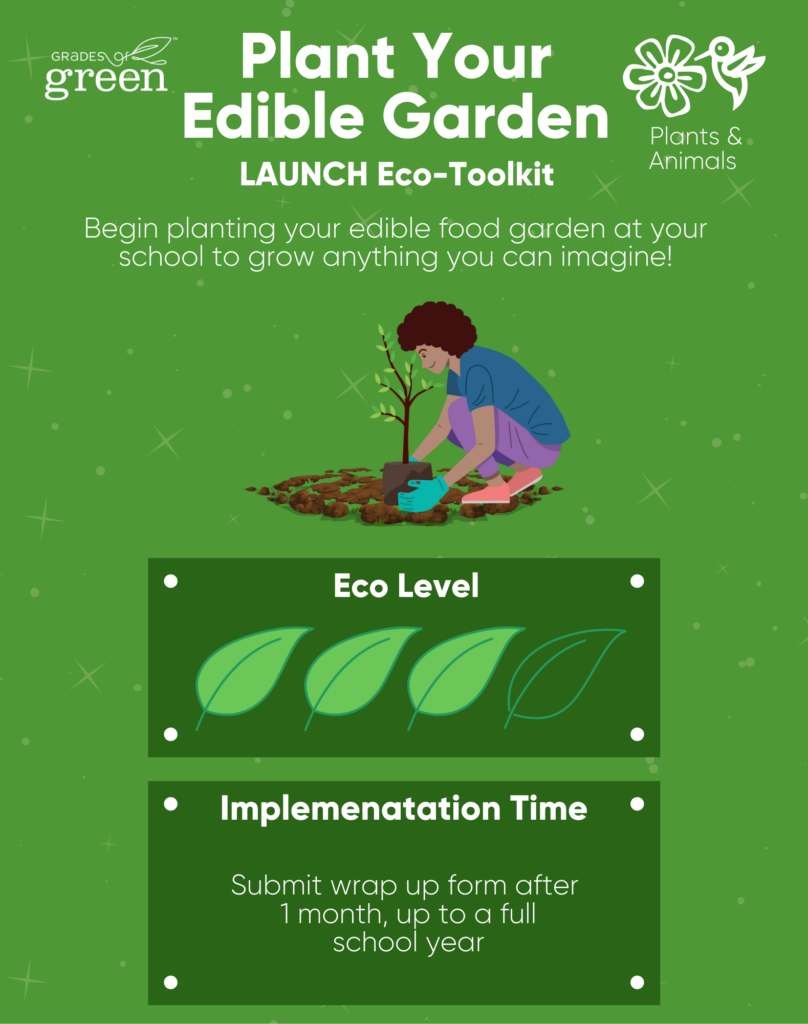All good projects start with a PLAN!
In the first toolkit of the Edible Garden series, you will learn how to create an effective plan to grow an edible garden. You will also discover the positive impacts edible gardens have on the environment.
Grades of Green is proud to partner with Palos Verdes School Gardens and Kellogg Garden Products to bring you this toolkit.

Toolkit Details


NGSS
This toolkit address the following Science and Engineering Practices (SEPs) within the Performance Expectations of NGSS for Grades: 6-8 and 9-12
- Asking Questions and Defining a Problem
- Planning and Carrying out Investigations
- Analyzing and Interpreting Data
- Using Mathematics and Computational Thinking
- Constructing Explanations and Designing Solutions
- Obtaining Evaluating, and Communicating Information
Learning Objectives
- Analysis
- Students will analyze their edible garden and determine best practices for planning
- Project Management
- Students will manage and maintain their own garden plan to develop project management skills
- Students will practice leadership skills by delegating tasks to each other
- Evaluation and Assessment
- Students will track and evaluate the impact of their edible garden
What is an Edible Garden and why is it important?
An edible school garden consists of plants that you can eat! Having an edible garden is a fun and educational experience that offers many benefits – (including being able to literally eat the fruits of your labor!). Gardens provide an opportunity to learn new skills while being outdoors, fostering teamwork, and promoting awareness of food systems, environmental responsibility, and stewardship. Gardens also encourage physical activity, personal growth, and support mental and emotional well-being. They serve as a platform for community improvement and social awareness, and promote sustainable practices and healthier food choices. (Source: KidsGardening)
What You Will Accomplish
You will be able to create a plan for your school edible garden by finding an ideal spot for a garden plot, determining what you should plant and where the seeds should go. You will also plan out a schedule for the initial soil work, planting, and maintenance (details on implementing these activities follow in the additional toolkits).
Why Should You Plan an Edible Garden?
The resources provided below can be shown as a slideshow or printed out as individual worksheets for students to review. For more background learning, please refer to the Plant, Maintain, and Harvest your garden toolkits!

Edible Gardens Reduce Carbon Emissions
Setting up gardens in schools, homes, or communities plays a vital role in reducing carbon emissions associated with food transportation. Transporting commercial fruits and vegetables from farms to markets creates harmful carbon emissions from trucks, planes, and ships. Surprisingly, the transportation of food alone is responsible for one-fifth of all emissions generated by the food industry. By growing our own food closer to where it is consumed, we can significantly decrease these emissions. School gardens, home gardens, and community gardens offer a sustainable alternative. When we cultivate our own produce, we eliminate the need for long-distance transportation. Instead, we can simply harvest fresh fruits and vegetables from our gardens, reducing the carbon footprint associated with food transport. So by growing food locally, we not only help combat climate change by reducing carbon emissions but also create a more sustainable and resilient future for ourselves and the planet we call home. [1]
It’s Better For Your Body
Growing your own food in a garden not only benefits the environment but also has significant advantages for our health. When we cultivate fruits and vegetables in our gardens, we have the opportunity to pick them at their peak ripeness, resulting in produce that is packed with nutrients. Compared to large-scale agricultural production, where crops are often harvested early for transportation purposes, garden-grown food tends to have higher nutritional value [2]. Freshly picked fruits and vegetables from the garden are rich in essential vitamins, minerals, and antioxidants that are beneficial for our bodies. Consuming nutrient-dense produce supports our overall health, strengthens our immune system, and contributes to our well-being.
Save Money
Additionally, growing your own food can lead to significant cost savings. By investing time and effort in a garden, you can produce a large amount of food at a fraction of the cost of purchasing the same quantity from the market. It reduces your grocery expenses and allows you to enjoy the satisfaction of eating food you have nurtured and grown yourself. By growing your own organic food in a garden, you can enjoy the double benefit of accessing highly nutritious produce and saving money in the process. It’s a rewarding and healthy way to take charge of your diet and promote a sustainable lifestyle. [2]
Why Food is an Environmental Justice Issue
Food deserts and food swamps are dire environmental justice issues. These terms describe communities where it is challenging to access fresh and healthy food options, leading to an overabundance of processed and unhealthy food choices. Unfortunately, people living in these areas often rely more on processed and fast foods rather than fresh produce. This not only has detrimental effects on their health but also contributes to environmental problems.
Ensuring access to fresh fruits and vegetables for all individuals not only improves their health but also benefits the planet. By promoting equitable access to nutritious food options, we can reduce the consumption of processed foods, decrease carbon emissions associated with food production and transportation, and promote sustainable food systems.
Addressing food deserts and food swamps requires comprehensive solutions, such as improving access to affordable fresh produce through community gardens, farmers’ markets, and urban farming initiatives. It also involves advocating for policies that support the equitable distribution of healthy food options, particularly in marginalized communities. By addressing these environmental justice issues, we can make positive strides towards healthier communities and a more sustainable future for both people and the planet.
Watch these short videos to learn more about planning a garden!
Think About It!
Pre-Activity Questions
- What are the benefits of creating a garden plan?
- What are some of the environmental benefits that can be addressed in our plan?
- What are some details that we should include in our plan?
- What are some organizations we can connect with to support our plan?
Take Action: LAUNCH the Plan of Your Edible Garden
Follow the steps below to harvest a successful Edible Garden at your school! Need help? Contact us!
Step 1. Create Your Edible Garden Team
Using the Edible Garden Roles Worksheet, assign or allow students to pick roles in order to plan a garden. Some roles can include:
- Outreach Specialist
- Garden Planner
- Plant Picker
Feel free to add more roles and get creative with the names to make it more fun!
Step 2. Meet Your School’s Decision Makers
Consult with relevant authorities, such as school administrators to obtain permission for an edible garden to ensure compliance with any regulations.
Step 3. Map It Out
Determine suitable locations for an edible garden. Make a list of areas that could work and benefit from an edible garden. Consider these factors when finding your garden location:
- Space availability: look for open areas such as empty plots, lawns, or unused sections of the schoolyard that are big enough to accommodate a garden.
- Sunlight exposure: choose spots that receive at least 6 hours of direct sunlight per day. Look for things like tall buildings or large trees that might shade the garden area.
- Accessibility: look for areas that are easily accessible for students. Select spots that are conveniently located near classrooms, common areas, or paths.
- Soil Quality: check the soil quality in potential garden locations. Look for areas with fertile soil that can support plant growth. If the soil quality is poor, consider implementing raised beds or container gardens.
- Water Availability: ensure there is a nearby water source or access to irrigation to provide adequate water for the garden.
- Once the location is decided on, name the garden! Encouraging involvement and pride in the project will foster a sense of responsibility and enthusiasm.
- Learn about different soils to use here for your type of garden
- Use this guide for tips on How to check for soil pH
- Search for inexpensive soil testing kits for free testing in your area
Step 4: What Type of Garden Will You Have?
When determining the type of garden that works best for a specific space and climate, consider the following factors:
These are ideal for spaces where the soil quality may be poor or where you want more control over the soil conditions. Raised Beds are large containers built on top of the ground, allowing you to fill them with high-quality soil. These beds provide better drainage and can help regulate moisture levels. They are particularly beneficial in areas with limited space or where the existing soil is compacted or contaminated.
Containers are suitable for various spaces, including small gardens, or areas with limited access to soil. Unlike raised beds, containers have a bottom and require proper drainage holes to prevent water logging. They offer flexibility in terms of placement and can be easily moved to optimize sunlight exposure. Container gardening allows for the use of different soil mixes tailored to specific plants and offers good control over soil quality.
Planting directly in the ground is an option if you have access to fertile soil and proper drainage. Before planting, test the soil to understand its composition and nutrient levels. This can help determine if any amendments or adjustments are necessary for optimal plant growth. In-ground gardens are suitable for larger spaces and can be more cost-effective than raised beds or container gardens.
Are you using Raised Beds? Use this guide! Learn about different soils to use here for your type of garden.
Step 5: Determine your Climate Zone (US only) and seeds
Before you pick your seeds, you first need to determine what “Climate Zone” you live in. Different areas have different types of climates and are suitable for different plants. Start by finding your zone from Kellogg Garden: https://www.kellogggarden.com/blog/gardening/how-to-find-your-planting-zone/
Next, use this resource to learn about what plants will work best for your Edible Garden:
- Download free Kellogg Planting Charts based on your Climate Zone to find what seeds work best for your garden (Zone Planting Charts can be downloaded as Google spreadsheets that you can edit and customize!)
- Learn new terms! “perennials” regrow every year while “annuals” only grow for one season and die off. Get more tips on planning your garden on Kellogg Garden’s website
- Check out these 10 tips for Designing your Garden Layout!
Step 6: Create a Grid
Using this video as a guide, create a grid for your seeds. Use this worksheet to plan your grid.
- Start with rows that go run North/South to ensure they receive the most sunlight.
- Make sure to have enough space around each seed so your plants can grow (different plants need different spacing, research how much space the plants you are growing will need).
Step 7: Gather Your Materials
Gather the materials you need to plan your garden! This can include the following:
- Seeds
- Soil
- Mulch
- Hand Shovels
- Trowels
- Garden Rake
- Garden gloves
- Watering cans
- Plant labels such as Popsicle sticks
Choose the seeds you want to plant and remember you can always add more, so start small.
- Help decide what seeds to plant by visiting Kellogg Garden’s Edible Garden page.
- Contact local nurseries or big box stores such as Home Depot and Lowes to see if they will donate supplies.
- Reach out to school parents and teachers for donations as well. Check out these resources for garden grants!
- A more extensive maintenance plan is outlined in Toolkit #3 of this garden series
Step 8: Maintenance Plan
Look to student and adult volunteers to determine how the garden will be maintained (watered, fertilized, weeded, and harvested) throughout the school year and during school breaks. How will tasks and garden responsibilities be divided?
- The whole team/club will work together on the whole garden.
- There will be several raised beds divided by grade level, class, or club.
- Students will rotate who’s working on the garden.
- Other? What are other ways you can divide the garden responsibilities?
Remember to look at your Edible Garden Roles Worksheet and update it as needed.
Reflection Questions
How’d It Go?
- What was the hardest part of the planning process?
- Which next step are you most excited about?
- What changes will you make the next time you are creating a plan?
Report Students’ Impact
Congratulations!! You’ve implemented Plan Your Edible Garden! Don’t let all that hard work go unnoticed. Submit your results by clicking the green button below.
Project ongoing? No problem! Let us know what you’ve done so far.
By reporting your impact, Grades of Green can:
- CELEBRATE and elevate your students’ hard work and success.
- Offer our programs FREE for all students across the globe.
- AWARD stipends and certificates to hard-working educators and students.
Please take a few minutes to submit your results. Thank you!
Next Steps
Congrats on Planning Your Edible Garden! Get started on Toolkit #2: Plant Your Edible Garden!

Provided Resources
- Edible Garden Series Google Resources
- Edible Garden Sign-Up Sheet
- Edible Garden Grid Plan
- Edible Garden Plan Wrap-Up Form
- Kellogg Harvesting Guide
- Kellogg Activities for kids with printouts
- Amending Soil – How to Amend & Care for Neglected Soil
- How to Start A Square Foot Garden
- Crop Rotation & Garden Planning For Plant Health & Pest Control
- What is Organic?
- Kellogg Raised Bed Gardening Guide
- https://kellogggarden.com/blog/soil/difference-between-garden-soil-and-raised-bed-soil/
- https://kellogggarden.com/blog/gardening/how-to-find-your-planting-zone/
- https://kellogggarden.com/organic-gardening-guides-2/
- https://kellogggarden.com/gardening-for-beginners/
- https://kellogggarden.com/blog/gardening/10-tips-for-planning-your-raised-beds-and-garden-layout/
- https://kellogggarden.com/blog/fruits-veggie-gardening/
- MAKE YOUR OWN – Square Foot Gardening SPACING TEMPLATE for beginners – VIEWERS REQUEST
- https://community.kidsgardening.org/browse-resources/funding-opportunities
Congrats on completing the planning your edible garden!
Did you enjoy this toolkit? Get ready to plant your edible garden!